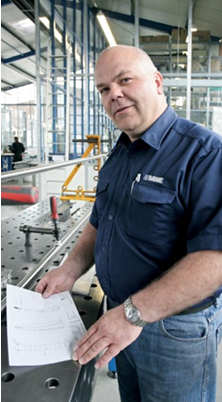Behind the scenes of how MWE ladders are made
A visit to the ladder department at the state-of-the-art manufacturing facility of MWE we peek over the shoulder of MWE specialist Thomas Rüschenbaum as he produces an SL.6003.KL Klassik telescopic ladder. Using the planning documents from the construction department, Mr Rüschenbaum gathers the material he needs. To make the beams of the telescopic ladder, he saws two stainless steel tubes of a suitable diameter to the desired length.
Welding table
Mr. Rüschenbaum attaches the spring fastener for the telescopic device by means of a hole in the upper end of the beam. A case that contains the guide piece for the weld shaft with the spring is welded to the pipe.
The beams are fastened on and welded together with two ladder cross pieces at the top and bottom. Now the ladder frame can be assembled on the welding table so that it does not have to be moved for as many work processes as possible. Special devices have been developed for most ladder types, making the complex craft work much easier.
precision welding the steps
The joint pieces for the wooden steps have to be attached next. As the customer wanted specific distances here, Thomas Rüschenbaum had to produce a template from the technical drawing, using which he can work out the distances taking the angle of the steps into account.
Before the logo has been etched on, the piece is thoroughly worked by hand with a fleece. The movements must always be in the direction of sanding to achieve the typical MWE finish.
Now the joint pieces are attached at points. This allows small angle changes later. Once all joint pieces are in the right place, they are welded on.
After welding Thomas Rüschenbaum uses a very mild acid to remove the oxide coating at the weld seams, energizing the stainless steel frame. Every product produced by the MWE stainless steel factory is branded by etching the logo on the stainless steel.
The feet of the ladder have a ball joint that adjusts to every angle of inclination. They are screwed into a threaded bush in the bottom of the beams. An installation aid simplifies the positioning of the foot. Precise rethreading is also carried out before this.
To fasten the head of the ladder to the telescopic equipment, the spring is connected to the weld shaft with the beam. The bottom end of the shaft is then inserted into the guide sleeve. Now Mr Rüschenbaum screws the carriage blade to the head of the ladder.
The rungs or steps are then put onto the ladder so that it can fulfill its main task. This ladder is given solid beechwood steps with two semi-circular bulges for the beams that are screwed to the joint pieces.
Mr. Thomas Rüschenbaum














